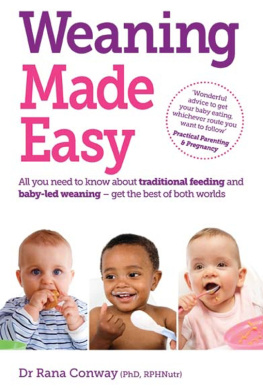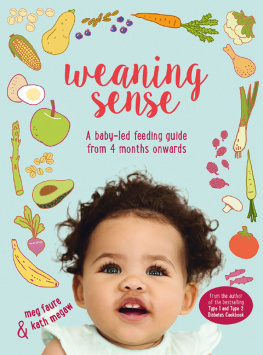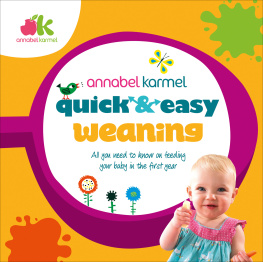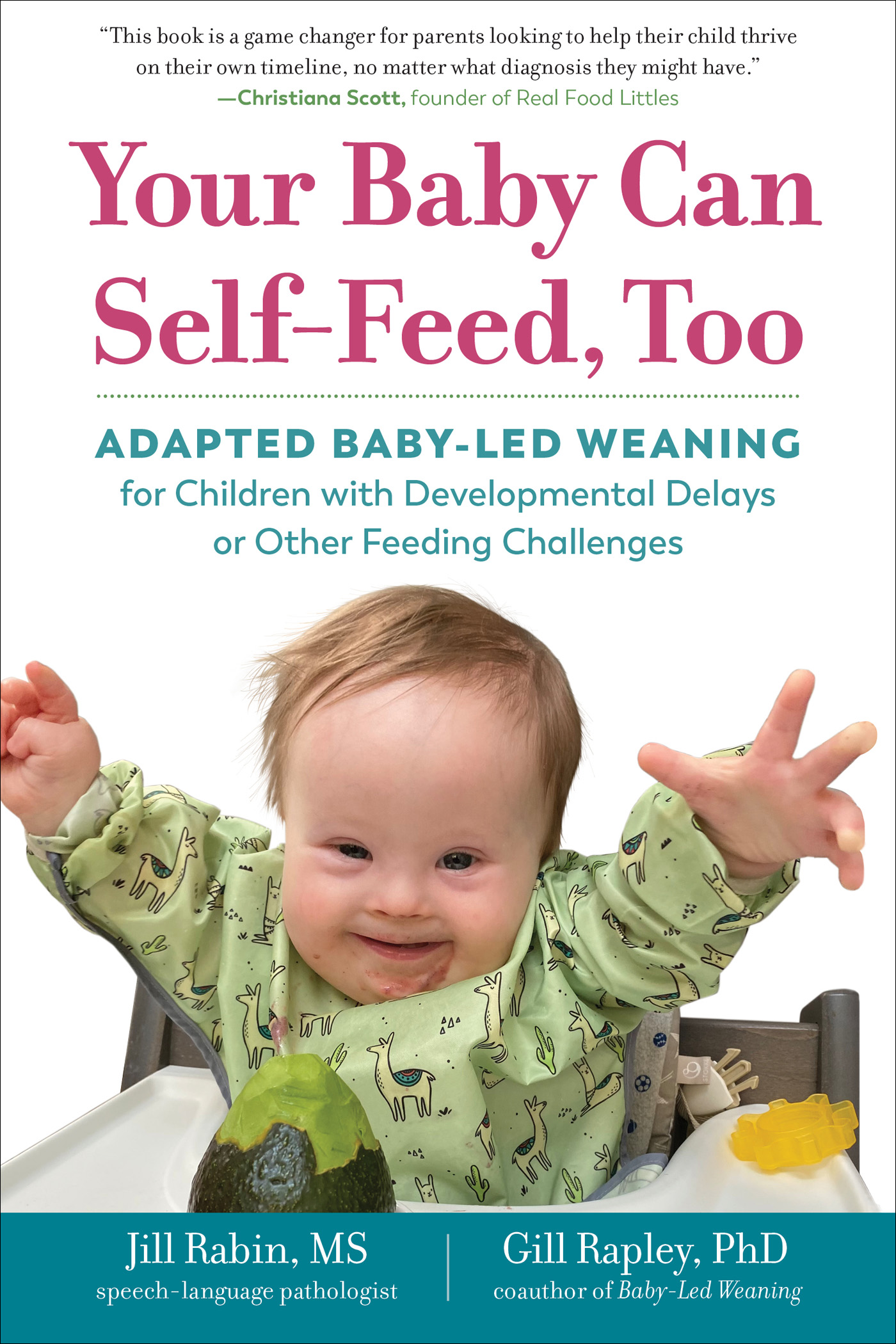Contents
Guide
Page List

Contents
by Jill Rabin
1: How We Got Here
Lukes Story
2: Baby-Led Weaning
Henrys Story
3: How Babies Learn to Eat
Reweys Story
4: Identifying Babies at Risk for Feeding Challenges
Addies Story
5: ABLW: Planning Ahead
Sophias Story
6: Getting Set Up
Adiels Story
7: Foods for Learning
Luans Story
8: Transitioning to Solids with ABLW
Micahs Story
9: Common Parental Concerns
Theodoras Story
Preface by Jill Rabin
T he first time I heard a lecture by Gill Rapley, pioneer of baby-led weaning (BLW), I was immediately transfixed. A colleague, Gail Macklin, had loaned me a DVD about the BLW approach and I became mesmerized by the footage of babies as young as 6 months feeding themselves with the same foods that their families were eating. When I saw how BLW worked for neurotypical babies, I knew I had to figure out a way to help babies with motor challenges learn to eat in the same way. What I didnt know was that this DVD would change the path of my career as a feeding therapist forever.
My work is primarily with neurodiverse babies with a range of diagnoses, including Down syndrome and Noonan syndrome, as well as babies born prematurely and those with a feeding aversion. I wanted to develop a way that these babies could learn to eat solid foods in the same self-directed way as their peers. Initially, I focused on babies with Down syndrome, many of whom were being spoon fed by adults into their second year of life, while continuing to drink from bottles rather than straws and cups and doing minimal self-feeding. Over the course of a few years, I discovered that it is not only possible for these babies to feed themselves but that there are huge benefits for them, too. Using observation, and a process of trial and error (and always with the full involvement of the babys parents), I devised and refined the approach that I now call adapted baby-led weaning (ABLW).
I began by developing ways to help babies with motor challengessuch as limited muscular strength and difficulty with refined hand and finger movementsfeed themselves using different food shapes and textures. I also experimented with bridge devices, such as silicone feeders and pre-loaded spoons, as I found the babies often struggled initially when relying on their hands and fingers. I was so excited to see how using these devices, with gentle and responsive support for the hand-to-mouth action, was helping them self-feed and learn to chew.
I found Gills contact information on her website and decided, albeit apprehensively, to email her about my adapted approach. I knew, from her book Baby-Led Weaning: The Essential Guide, that she and her coauthor Tracey Murkett were unsure whether BLW was appropriate for babies with developmental challenges but theorized that it had the potential to be therapeutic. I wanted to show her just how well her ideas do work with this population. However, while I was convinced that adapting BLW was good for my patients, I worried that Gill would not approve of the use of feeding devices and other adaptations, since they are not part of the core concept of BLW. I felt strongly that these activities could act as a bridge, enabling babies facing feeding challenges to transition much more quickly to self-feeding than was generally assumed to be possible.
I reached out to Gill in July 2014, outlining how I had adapted her methods for neurodiverse babies and asking whether she would like to see some of the videos I had made of the babies I was seeing (with their parents permission). I waited with trepidation for her response for what seemed like an eternity (but was in fact one weekshe had been on vacation). I could hardly believe it when she said she was very interested in what I was doing and eager to learn more! From this initial contact, a friendship evolved between the two of us BLW nerds, who share a passion for the approach. We exchanged current information and research on BLW, as well as videos and photos of babies self-feeding. We also discussed how best to describe and promote my adapted approach, how to educate colleagues, and how to respond to those who made disparaging remarks. With Gills encouragement I started to speak more widely about my work to groups of professionals and parents, but in the back of my mind I knew I wanted to reach a wider audience.
My first lecture on ABLW was in 2016, at a conference for feeding therapists in Illinois. My methods were initially met with disdain and skepticism and I was told by therapist friends in the audience that some of the attendees thought what I was doing was outrageous, and potentially dangerous. They felt that babies with feeding challenges needed to be spoon fed by an adult and that spoon feeding was a necessary step in feeding development. I knew this wasnt the case but I wasnt sure how to convince others. I kept plugging away at my practice, seeing every day the benefits of ABLW but feeling frustrated that no one else was able to witness firsthand how beneficialand safethis approach was.
The big breakthrough came in the summer of 2018, when I met Lori Overland, a speech-language pathologist, at a weeklong orofacial myology course in New Jersey. Lori is well known in the pediatric feeding world and is a popular lecturer and author of books about feeding. She and I bonded over our feeding work with the 0-to-3-year-old population, and babies with Down syndrome in particular. Over lunch every day, we would sit together and discuss our different feeding cases. I eventually got up the nerve to show her some videos of my neurodiverse patients feeding themselves. She would later tell me that she initially thought what I was doing was ill-advised, as it seemed to her that some of the babies were using compensatory patterns to eat with this approach. Nevertheless, when she returned home she started trying bridge devices with a few of her patients. She quickly saw the benefits when ABLW was combined with the sensory-motor approach she had devised (described in ) and asked me if I would be willing to combine our approaches. She suggested we submit a proposal to the American Speech and Hearing Association (ASHA) for a joint presentation to our peers at the ASHA national convention, one of the largest gatherings of feeding professionals in the country. Our vision became a reality in 2019, when we showcased the Sensory-Motor Approach to Baby-Led Weaning in Orlando, Florida.
Loris reputation meant that many of her colleagues, also accomplished in the field of feeding, attended our presentation. Her endorsement of, and belief in, ABLW brought the idea to the forefront of the specialty, which meant it could no longer be ignored. That day marked a shift in many peoples perception of what might be possible, and interest in the approach started to gain speed. The following year Lori and I were invited to write a guest post for the online blog Pediatric Feeding News. In parallel, 2020 saw the launch of the Instagram account @ableappetites, which Sara Quirk and Sabrina Smiley Evans, both moms of babies with Down syndrome, had developed specifically to help families of babies with this diagnosis transition to solids using family foods. At the time of writing, a plethora of websites and social media accounts are embedding the concept of BLW and finger foods as first foods into our culture. A baby-led approach for








